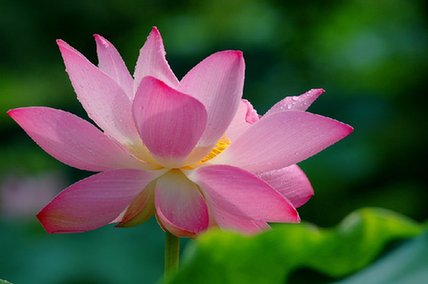
The ethereal lotus flower is a familiar image in China, depicted widely in many traditional paintings and carvings. During the summer months, these stunning flowers and their giant lily pads blanket parts of Beihai lake and other stretches of water in Beijing. But it is only recently that I made the connection between these blooms and the various edible parts of the plant.
In China, the most widely consumed parts of the lotus plant are the rhizomes or lotus roots (lian ou). Buried in the water beneath the flowers, these roots form a series of long, creamy-brown nodules, similar in size to a sweet potato but more uniform in shape.
When sliced vertically, the pale white flesh is seen to be decorated with an almost lace-like design caused by hollow channels running through the roots.
Lotus root is a crisp, starchy vegetable which absorbs flavors well and is particularly good added to stews of slow cooked meat stews. Once such dish is lian ou pai gu - lotus root and pork ribs, where the ribs are boiled slowly over several hours and the lotus root added about 20 minutes before the end in order to retain some bite.
The crisp and succulent nature of the younger lotus roots means they also work well in cold dishes and salads served simply as liang ban - briefly cooked sliced lotus roots dressed with vinegar, garlic and spices and chili.
You can experiment with the dressing - I like to add a little chili oil, soya sauce and chopped coriander leaves to the vinegar and then sprinkle over some sesame seeds before serving.
The latticed shape of the root lends itself to stuffing, and the neutral root flavor means it also works well with sweet dishes. Gui hua nuo mi ou is a sumptuous combination of sticky rice mixed with osmanthus flowers and honey, then stuffed into the channels of a whole lotus nodules, this concoction is then steamed, chilled and served in slices.
From a nutritional perspective - lotus root has a similar carbohydrate and calorie content to potato but contains significantly more iron, vitamin C, potassium and fibre - making it an especially heart healthy alternative.
The seeds of the lotus plant (lian zi) have long been used in traditional Chinese medicine (TCM). They can be eaten raw, but are often dried and the boiled till soft and tender. Their texture is mealy and bean-like with a faintly sweet flavor. Often they are paired with sweeter ingredients; made into sweet rice porridge as one of the treasures in eight treasures congee (lian zi ba bao zhou), crystallized with sugar to be placed amongst other goodies on trays at Chinese New Year or mashed into a paste to be used as a filling for Chinese moon cakes.